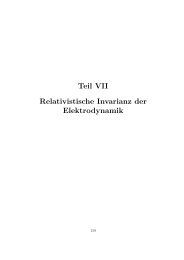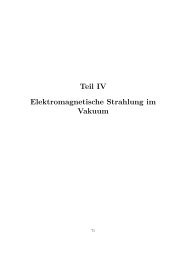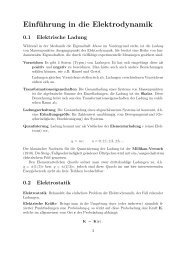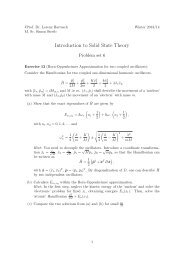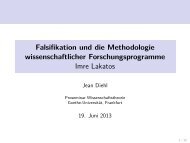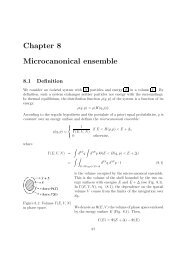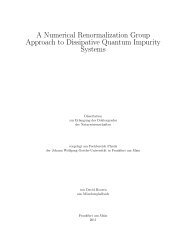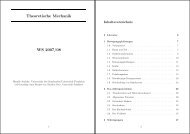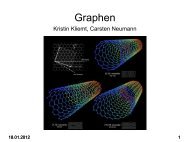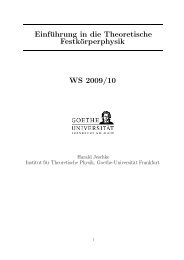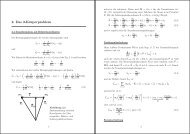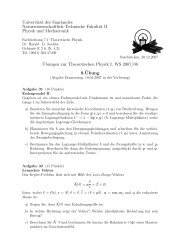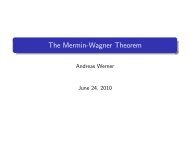Microscopic Modelling of Correlated Low-dimensional Systems
Microscopic Modelling of Correlated Low-dimensional Systems
Microscopic Modelling of Correlated Low-dimensional Systems
You also want an ePaper? Increase the reach of your titles
YUMPU automatically turns print PDFs into web optimized ePapers that Google loves.
List <strong>of</strong> Figures x<br />
5.1 Comparison between the total and partial DOS obtained for (a) the polymer<br />
without relaxation (experimental structure) CuCCP and (b) the relaxed<br />
CuCCP polymer. . . . . . . . . . . . . . . . . . . . . . . . . . . . . . . . . . 76<br />
5.2 Orbital resolved DOS for the relaxed structure CuCCP. The contribution <strong>of</strong><br />
the Cu s/O s/N1 s states are smaller than 0.1 % in this region and therefore<br />
are not shown. . . . . . . . . . . . . . . . . . . . . . . . . . . . . . . . . . . 77<br />
5.3 Band structure for the relaxed Cu(II) polymer CuCCP in the GGA approximation<br />
along the path [22] F(0, 1, 0)-Γ(0, 0, 0)-Z(0, 0, 1)-B(0.99, −0.13, 0)-<br />
Γ(0, 0, 0) in units <strong>of</strong> π/a, π/b, π/c. The bars indicate the dominant band<br />
character in the local coordinate frame <strong>of</strong> Cu (see text for explanation). . . 78<br />
5.4 Cu-Cu interaction paths ti, where the index i = 1, 2, 3, 7, 8 denotes the ith<br />
neighbor. . . . . . . . . . . . . . . . . . . . . . . . . . . . . . . . . . . . . . 80<br />
5.5 Partial spin-polarized DOS for the relaxed CuCCP compound. In it the<br />
contribution from spin up (upper panel) and spin down (lower panel) are<br />
shown. For simplicity the total density <strong>of</strong> states have been removed. . . . . 81<br />
5.6 Band structure for CuCCP in the spin-polarized calculation. (a) spin up and<br />
(b) spin down. . . . . . . . . . . . . . . . . . . . . . . . . . . . . . . . . . . 82<br />
5.7 Four unit cells <strong>of</strong> CuCCP where two hydrogen atoms in the hydroquinone<br />
rings have been substituted by two amino groups. Notice the tilting <strong>of</strong> the<br />
hydrogen atoms belonging to the molecule NH2. . . . . . . . . . . . . . . . . 83<br />
5.8 Orbital resolved DOS for (a) Cu(II)-NH2 and (b) Cu(II)-CN; (c) comparison<br />
between the contribution <strong>of</strong> NH2 and CN groups to the DOS at EF in a<br />
blown up scale, the green line indicates the contribution <strong>of</strong> the N s states in<br />
this energy range. . . . . . . . . . . . . . . . . . . . . . . . . . . . . . . . . . 84<br />
5.9 Comparison <strong>of</strong> the band around the Fermi level between (from top to bottom)<br />
the relaxed CuCCP, Cu(II)-NH2 and Cu(II)-CN respectively. In all cases the<br />
same path in the irreducible FBZ described for CuCCP was used. . . . . . . 86<br />
5.10 3D charge density in the energy isovalue ρ = 0.003 e/˚A 3 for (a) relaxed<br />
CuCCP polymer, (b) Cu(II)-NH2 polymer, and (c) Cu(II)-CN polymer; (d)<br />
indicates the atom positions common to (a)-(c). The N-C-C-C-H chain <strong>of</strong><br />
atoms appearing above the chains belongs to the next layer. . . . . . . . . . 88<br />
5.11 Crystal structure <strong>of</strong> the Cu(II) polymer with water ligands (Cu(II)-H2O).<br />
Shown are also the unit cell (vectors a, b and c) and the hydrogen bonds<br />
(dashed lines). . . . . . . . . . . . . . . . . . . . . . . . . . . . . . . . . . . 89<br />
5.12 Crystal structure <strong>of</strong> the Cu(II) polymer with ammonia ligands (Cu(II)-NH3).<br />
Shown are also the unit cell (vectors a, b and c) and the hydrogen bonds<br />
(dashed lines). . . . . . . . . . . . . . . . . . . . . . . . . . . . . . . . . . . 90<br />
5.13 Orbital resolved DOS for (a) Cu(II)-H2O and (b) Cu(II)-NH3. . . . . . . . 92<br />
5.14 Band structure <strong>of</strong> Cu(II)-H2O compound. (a) the bars indicate the dominant<br />
band character in the local coordinate frame <strong>of</strong> Cu (see text for explanation)<br />
(b) detailed plot <strong>of</strong> the band structure around the Fermi level. . . . . . . . 93<br />
5.15 Band structure <strong>of</strong> Cu(II)-NH3 compound. (a) the bars indicate the dominant<br />
band character in the local coordinate frame <strong>of</strong> Cu (see text for explanation.)<br />
(b) detailed plot <strong>of</strong> the band structure around the Fermi level. . . . . . . . 95



